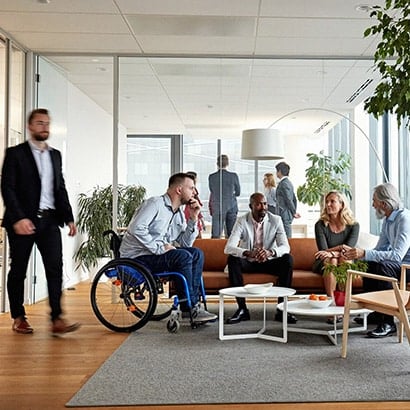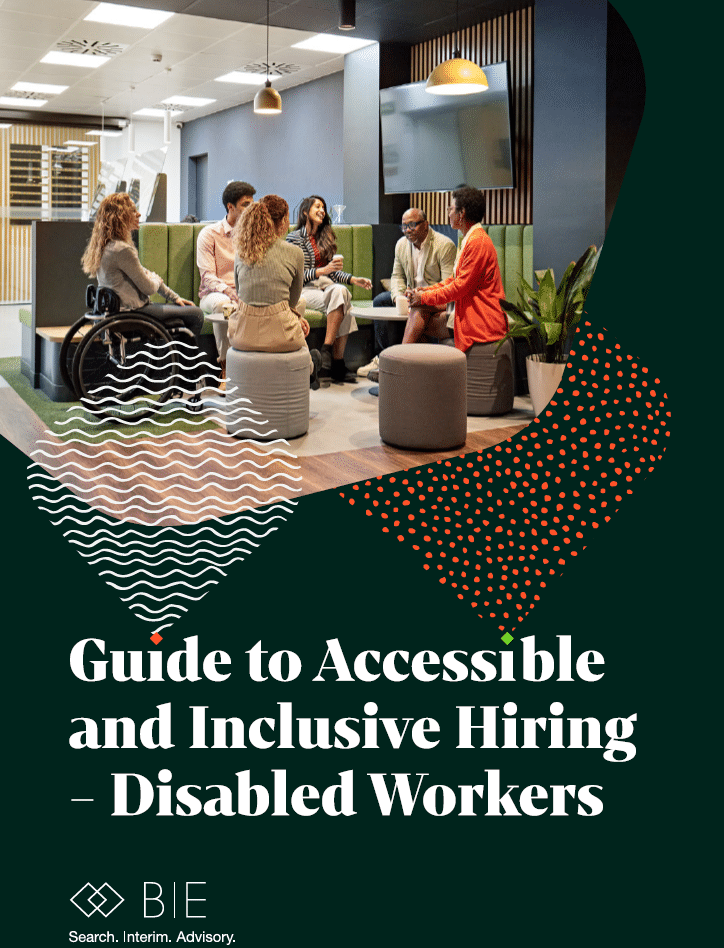
Worldwide, around 1 billion people – about 15% of the global population – live with a disability, and this number is increasing as the population ages. Indeed, most of us will experience some form of disability during our lifetime.
In the UK, the data reveals that 83% of disabled people acquire their disability during their working lives. In fact, 21% of working adults in this country have a disability, but with many workplaces unable or ill-equipped to support them, around 400,000 people each year leave the UK workforce after developing a condition.
According to the ONS, only half of disabled people (53%) in the UK are in employment, compared with 82% of non-disabled people. Organisations can seize the opportunity to recruit from this large, skilled talent pool – if they can create workplaces and hiring processes that are inclusive and accessible for everyone.
According to research conducted by Scope, 1 in 3 people feel there is a significant amount of prejudice surrounding disability. It’s revealing therefore that the same study also found that 1 in 3 consider disabled people to be less productive than non-disabled people. In fact, research suggests that disabled people often outperform their non-disabled counterparts. Disability Positive has broken down some other common misconceptions here.
Negative judgements and prejudices are major barriers to inclusivity, and should be challenged if they arise. It’s important that your hiring professionals, as well as managers, receive training in accessibility and inclusivity in order to combat any misconceptions and bias, and ensure that you’re creating an environment where candidates and employees alike are able to thrive.
Build on your training by actively educating people on the value of difference, and the advantages it brings. With this in mind, you should make sure that disability is embedded into your broader D&I strategy – and not an afterthought.
With 1 in 5 working adults in this country living with a disability, the likelihood is that your organisation employs more disabled people than you think. However, getting accurate data can be challenging.
The vast majority of disabilities are not immediately visible, and many people, understandably, do not want to disclose their disability due to fears that it will cause problems for them. There is no requirement for people to tell their potential or current employer that they have a disability – and employers must not ask.
It is in everyone’s best interests, however, if employers can create safe, welcoming spaces where people feel comfortable sharing their lived experiences, particularly if that means disabled people can articulate their needs and have them actioned.
Anonymous surveys can be helpful in gathering employee disability data, allowing people to choose whether or not to share information. Nevertheless, even without specifics there are steps you can take to make your workplace more accessible and inclusive for everyone, from altering your premises, to offering flexible working hours.
It is important to note that gathering data requires a measure of trust on the part of your employees – and that must be earned. As you continue on your inclusion journey, committing to and enacting positive change, your team may feel safe to open up. In the meantime, consider working with experts, like Business Disability Forum or Disability Rights UK, to supplement your knowledge and understanding.
Publishing an in-house policy is not a legal requirement, but it can be beneficial, letting your team and potential employees know that you are dedicated to being inclusive.
And enshrining your values in writing provides a measure of protection for those who might otherwise feel vulnerable. It is also a clear sign to potential employees; disabled candidates will look for signs that yours is a safe, tolerant and inclusive workplace.
For examples of disability policies, the World Health Organization and the University of Cambridge have good examples. Also consider creating an internal hub, like the University of Glasgow, bringing together any materials you provide, services you offer and accessibility options for your premises.
It’s also important to be open about your commitment to making reasonable adjustments in order for your employees to fulfil their roles. And be sure to clearly state in your job ads that you will make adjustments during the hiring process as well. This lets potential candidates know you are not just open to them applying, but actively encouraging them.
Consider getting accredited as a Disability Confident Employer or Mindful Employer to further signal your intention to welcome disabled people into your organisation. Measures like these can act as positive forces for change in your industry and help improve your offerings for all people working for you.
To successfully create an inclusive culture, you need not only the support of senior leadership, but their active participation. Internal role models can be helpful, sharing their experiences and raising awareness.
If one of your senior managers takes afternoons off to manage chronic fatigue or to care for a relative with a disability, for example, perhaps they might feel comfortable sharing that. Usualising conversations about managing disability in the workplace can make a huge difference.
You need advocates and allies in the business to help drive change and, crucially, to revisit policies, programmes and targets. Making your workplace inclusive isn’t a one-and-done action – it is an ongoing process of learning, improving and changing.
To get senior management on board, you can make the business case from a variety of angles. Only half of disabled people of working age are employed, for example, which, in the current recruitment landscape, is a vast pool of untapped talent. Diversity is also well-attested to introduce more viewpoints into the organisation, leading to greater creativity and innovation. There are numerous benefits to reap in terms of employee retention and loyalty, as well as better business performance. In addition, disabled people and their households are estimated to be worth £274 billion a year to UK businesses as consumers, according to Purple.
Whether you’re designing new policies, implementing new systems, or gathering ideas, involving your people is a sure-fire way to work towards creating an inclusive culture.
Open up the process as wide as you can and invite people to test systems and check their accessibility. Ask candidates how you can make the hiring experience the best it can be – for them. And remember that even if people are designing new systems with the best of intentions, biases can get built in. So get more perspectives on what you’re working on, and work together.
To boost understanding company-wide, raise awareness, track progress and support disabled employees, companies could also consider setting up Disabled Employee Networks (DENs).
Offensive, condescending and derogatory language is unacceptable in the workplace. However, harmful language has slipped into common parlance, which people use day to day without thinking.
For someone who is non-disabled, phrases like “falling on deaf ears” or “that’s crazy” might seem innocuous, but they are linguistic micro-aggressions. Organisations could flag “ableist” language in their in-house policies, or provide guidance on their website. The government has provided some helpful guidance on inclusive communication for people to follow.
Ultimately, it’s important to focus on intention. If people want to respectfully and consciously use the correct language, but are unsure, they should ask. However, problems arise when, worried about saying the wrong thing, people say nothing. According to Scope, two-thirds of Britons are uncomfortable talking to a disabled person – which is a worrying statistic, considering there are 14.6 million disabled people in the UK, almost a quarter of the total population. Companies could consider incorporating Scope’s End the Awkward campaign efforts into their approaches.
Employers in the UK have a legal obligation to make reasonable adjustments to reduce or remove the disadvantages experienced by an employee doing their job, or a candidate applying for one.
Despite this requirement, there is stigma attached to and a vulnerability involved in making requests. 34% of disabled respondents to the Great Big Workplace Adjustment Survey, who would have benefitted from an adjustment, did not ask for one due to fear of their employer treating them differently. The figure was similar for those worried about the reaction of their colleagues.
Mindset is vital – if you want every candidate to show themselves at their best, ask yourself what you can do to help make that happen. With this in mind, be proactive and consider a range of possible adjustments you can accommodate ahead of time, and work with experts who can help you identify possibilities. With preparation, you can make the offer of adjustments (and give examples) at all stages of the process in full confidence that you can deliver on it, which will let the candidate know that it is a real possibility.
The most common types of adjustments relate to flexibility and often require minimal cost. However, if cost is a concern, the Access to Work scheme might be able to help. Adjustments vary according to the needs of individuals, but they can include:
Have any unnecessary barriers been built into your hiring processes and systems? Check whether your website and digital job applications system are accessible. And take a look at your job descriptions and announcements to evaluate what is actually necessary to ask of candidates.
It’s worth considering if you can reframe requirements to focus on the end result, not mandating how candidates would get it done. For example, do you actually need someone to “drive” to other locations, or do they just need to be able to travel? Do they need to have good oral skills, or just good communication skills? Think about the “why” of what you’re asking for. This guide from EARN has some useful advice.
Your people are your public face for candidates, so make sure that your hiring managers are trained to be mindful of disabilities, knowledgeable of the law (particularly the Equality Act 2010), cognisant of adjustments and aware of bias so they can provide applicants with the best possible experience.
To download a PDF version of this guide please click here.
If you would like any assistance with making your hiring processes fully inclusive, from resources to hands-on guidance, please contact our E,D&I lead Eoin Canty and he will be happy to advise you.
A selection of further resources:
